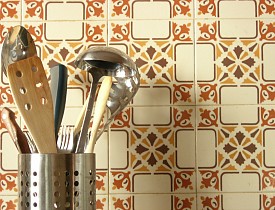Sealing and Maintaining Kitchen Backsplashes
 Unlike showers and tub surrounds, most kitchen and bathroom backsplashes are installed on regular drywall, rather than backer board. In these applications, special concerns should be addressed to limit potential water damage. Before installing backsplashes, consult a drywall contractor near you to make sure your drywall is safe to install on to prevent any problems down the road.
Unlike showers and tub surrounds, most kitchen and bathroom backsplashes are installed on regular drywall, rather than backer board. In these applications, special concerns should be addressed to limit potential water damage. Before installing backsplashes, consult a drywall contractor near you to make sure your drywall is safe to install on to prevent any problems down the road.
Laminate Backsplash Concerns
A laminate countertop is very cost-effective compared to granite or fancy imported marble and tile. Laminate counters fall into two basic groups, the simple flat style and those with a molded curve in the back so that the counter and the backsplash are a single piece. The latter are watertight from the factory and maintenance is pretty much eliminated.
Flat laminate countertops usually come with a separate piece of the same material, about 4" tall and the same thickness and width as the counter. Additionally, there is a smaller length, often called a sidesplash, that is used running front to back on the short edge of the counter. This is normally adhered to the wall with construction adhesive or adhesive caulk.
To protect the particleboard core of the laminate, a bead of caulk should be used to seal the joint along the entire corner. Caulk that matches the color of the laminate or basic clear will look good and provide the protection you need. Because the core of laminate counters is vulnerable to moisture, routine inspection of the caulk line is important to keep it sound, especially in the area directly behind the sink, which sees the most water.
Sealing Tile Backsplashes
Tile backsplashes are perhaps the most common type found in homes these days, as they can be used with countertops made of laminate, tile and solid slab materials such as Corian and granite. The corner joint in these installations may be caulked or grouted. Grouted corners give a uniform appearance that matches the field tiles, but unfortunately this joint is very prone to cracking and separating. When cracks occur, caulking and regrouting are both viable options.
Fixing a cracked grout line is not terribly difficult and can be repeated over and over as needed. However, there is a better way, which I have been using for years with great success:
During the tile installation, I place tile spacers below the bottom course of tile, most often 3/16”. When grouting time comes, I mask off the gap between the counter and the wall tiles with some painter’s tape. (If the counter is tile, I like to grout this before the wall tiles are installed.) With the corners protected from stray grout, I grout the wall tiles, let the grout cure and clean up as usual. After the wall grout sets -- usually the next day -- I pull the tape and clean out the corner channel. This corner then gets caulked.
Caulk is available to match nearly every available grout color, both sanded and un-sanded, and is normally stocked at big box stores. (If not, grout-colored caulk can be specially ordered. Obviously, getting your order in before the projects starts is a good idea if you are planning to use more exotic colors.)
When the colored caulk line is fully cured, it is almost impossible to distinguish from the grout, making the installation appear seamless. After the required cure time has elapsed, the grout is finished with a penetrating sealer. This helps with cleaning issues and protects the substrate behind the tile. Having a waterproof and flexible barrier in the corner provides years of protection.
When the time comes, a simple re-caulking will bring this vulnerable location back up to tiptop shape.
Solid Slabs and Solid Backsplashes
Installing a continuous strip of granite, as a short backsplash, on a granite counter is very much like the laminate installs above but since granite is waterproof already, a simple bead of caulk can be used to adhere the bottom of the backsplash to the top of the counter. This is all that is generally needed to prevent water from wicking its way under the backsplash. As an added measure, some folks will caulk the corner again once the back is set.
For professional kitchen backsplash installation, find a reliable tile contractor.
Updated January 22, 2018.
Looking for a Pro? Call us (866) 441-6648

Tile Contractors Experiences

Newly Tiled Floor For A Rental Property

Why I Chose Tile Floors After A Horrible Water Damage Experience



